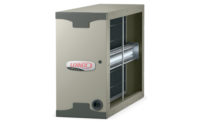ATLANTA — “Expanding on what we are following in the industry, we see more utilities and state agencies offering rebates and incentives for air-source heat pumps to meet ‘decarbonization’ and ‘zero-net energy’ residential building strategies.”
Victor Flynn, senior product manager for Panasonic, shared that perspective when asked for trends that are influencing the manufacturer’s choices and strategies these days.
Read more about
AHR Expo 2019
in the Feb. 18 issue
Indeed, if decarbonization is an unfamiliar word for some, it is not for the several organizations carrying out research about how to meaningfully reduce carbon output without doing significant damage to the economy, using an organized state-level plan.
States such as Washington are already engaged in analyzing these ideas and potential ways to pursue them, while the Sustainable Development Solutions Network and Hydro Quebec have published a paper about a comprehensive regional decarbonization strategy that would involve not only the Northeast states but parts of Canada. Flynn noted that rebate programs to encourage less oil and gas consumption are also helping — particularly, again, in the Northeast. That aligns nicely with recent industry progress in mini split heating performance in increasingly cold climates and regions.
Panasonic is already seeing some of this in the field. Flynn said that the largest-growing equipment segment he is seeing is multi-zone heat pumps.
Having set the scene for that part of the marketplace, what to do about it?
Judging by the emphasis in the AHR booth, Panasonic is working to differentiate itself by putting considerable emphasis on health and IAQ in these spaces. Even though it is not scheduled to reach the U.S. market until early 2020, the offering getting the most attention this year was nanoe™X.
The technology offers an advanced air purification system. NanoeX is nano-sized electrostatic atomized water particles that are rich in hydroxyl (OH) radicals — highly reactive components. It is generated from moisture in the air that contains the OH radicals, which react by transforming hydrogen from pollutants into water.
The company sees it as revolutionary for its effectiveness (and cost effectiveness) in deodorizing common unpleasant odors, and for inhibiting growth of bacteria and viruses to provide a cleaner and fresher indoor environment.
As an additional benefit, nanoeX has been shown to help retain skin moisture to reduce dryness issues. In fact, Flynn made clear that while this moisture byproduct is a secondary benefit in an application like this, it is noticeable enough that the manufacturer already incorporates it into its hair dryers for a more pleasant customer experience.
While this technology has yet to serve homeowners domestically (it has been “successful globally,” according to the company), the company believes nanoeX will do well as part of the Panasonic EXTERIOS XE ductless system and expects it to set a new standard for comfort and IAQ for the U.S. ductless heat pump market.
Panasonic reports that outside the U.S., it has done well not only in residential but in railway, automobile, hotel, hospital, and other public spaces. The company singles out the hospitality industry as having special possibilities, given the array of odors associated with kitchen, cleaning, or even smoking that can distract patrons.
Meanwhile, Panasonic has collaborated with Schneider Electric to develop its next-generation VRF Smart Connectivity Controls. Building managers in commercial settings can appreciate a single user-friendly interface that allows them to manage equipment, lighting, security, electrical distribution, and power either on location or remotely.
The attention at AHR this year wasn’t all on nanoeX or future releases. In addition, Panasonic showcased its ECONAVI intelligent sensor technology.
This technology gives equipment the capability to detect human activity and automatically adjust the temperature in a room to better suit the occupant’s circumstances. If enabled, it will even shift the vanes’ position to redirect more airflow toward the user.
On that note, Panasonic is paying attention to where the customer needs and opportunities are on both a micro and macro level, with plenty going on this year but an eye toward a momentous year in 2020.
Publication date: 2/18/2019
Want more HVAC industry news and information? Join The NEWS on Facebook, Twitter, and LinkedIn today!








